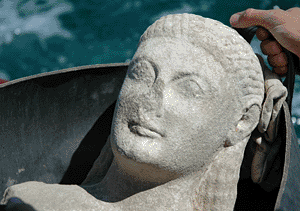
A first look at a previously unknown Aegean sanctuary

This head, found in 2010, belongs to a statue of a young male.
(Courtesy Yannos Kourayos)
The islands of the Aegean Sea, and particularly the Cyclades, are known not only for their exceptional beauty, but also for the richness of their archaeological heritage. Despite its small size, the island of Despotiko, which the ancient geographer Strabo called Prepesinthos, was well known because it had a protected harbor that was a safe stop for ships trading between mainland Greece, the Mediterranean, and North Africa. It also had an important Archaic period (ca. 700–480 B.C.) sanctuary dedicated to the god Apollo and his sister Artemis.
After the end of the Roman period in the second century A.D., the island was mostly abandoned, and only a few buildings were added later—a small medieval castle (built from ancient materials), a nineteenth-century sheepfold, and a church of the Virgin Mary built in the seventeenth century. Thus the uninhabited island looks much as it did more than five centuries ago.
Archaeologist Yannos Kourayos first visited Despotiko 15 years ago and has returned there every year since to excavate the sanctuary, which consists of 12 buildings including at least two small temples. "When I first came to Despotiko, I saw many ancient architectural elements being used as part of the wall of the sheepfold. That was enough to interest me in digging there, because I knew there must have been more where those came from." There had been two other excavations on the island—the first at the end of the nineteenth century, which uncovered a prehistoric cemetery (ca. 3500 B.C.), and a second, beginning in 1959, which exposed several ancient walls. But until Kourayos started digging, the sanctuary of Apollo was unknown either from the ancient written sources or from the earlier excavations.

To read more, find ARCHAEOLOGY in your local newsstand or bookstore, or click here to buy a copy of the issue online. And if you'd like to receive ARCHAEOLOGY in your mailbox, click here to subscribe.
Yannis Stavrakakis is ARCHAEOLOGY'S Athens correspondent.
Advertisement

Advertisement







